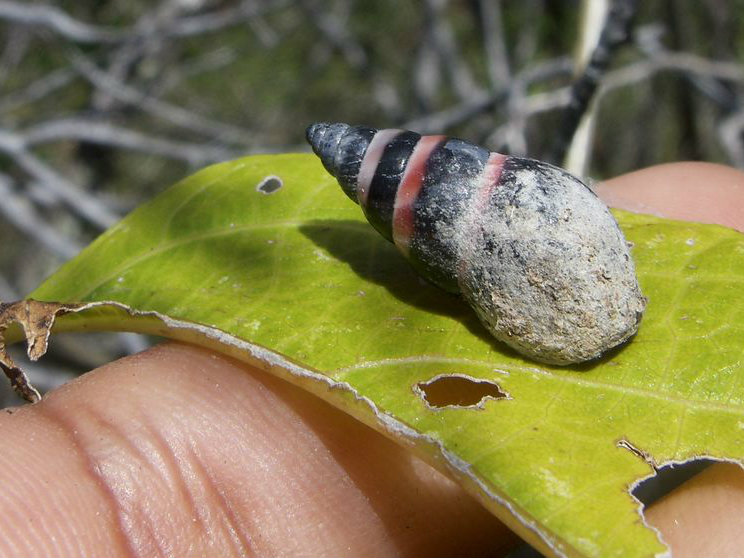
The story of the “extinct” giant snail – supposedly killed by global warming, but recently found alive and well on the same Indian Ocean atoll it has inhabited for the last 80,000 years – is developing into a major environmental scandal.
A scandal that obviously deserves the title Snailgate.
As we reported ten days ago under the heading Extinct Giant Snail Killed By Climate Change Crawls Back From The Dead, the sorry tale began in 2007 with the publication in one of the Royal Society’s journals Biology Letters of a “peer-reviewed” study by Justin Gerlach.
Gerlach’s study claimed that the Aldabra Banded Snail (Rhachistia aldabrae) had gone extinct in the late 1990s due to climate change.
However, this was immediately disputed by four experts in the field, led by Oxford University ecologist Clive Hambler who argued that there simply wasn’t enough evidence to justify to claim, and urged Biology Letters to print their prepared rebuttal.
It said: “The vast majority of the habitat is virtually inaccessible and has never been visited. It is unwise to declare this species extinct after a gap in known records of ten years. We predict ‘rediscovery’ when resources permit.”
Had Biology Letters published this, it would have spared itself the embarrassment of being proved wrong this year when the snail was indeed rediscovered, alive and well, on its island home.
Instead, Biology Letters refused to publish the rebuttal on the grounds that it had failed to pass “peer-review.”
Thanks to new research by Times environment correspondent Ben Webster, we now have an inkling as to how this may have happened. The two “peer-reviewers” who accepted the erroneous J Gerlach paper were the same two referees who rejected the subsequent rebuttal paper. Though their reasons for doing so are unclear, one evident possibility is that they did not wish to make themselves look foolish by accepting a paper explicitly rejecting the one they had so recently approved.
None of this would have come to light if the snail had stayed conveniently “extinct.” Unfortunately for the Royal Society, Biology Letters, J Gerlach and those two “peer-reviewers”, the resurrection snail has come back to haunt them by raising some very awkward questions.
Like:
What on earth did Biology Letters think it was doing submitting Hambler et al’s rebuttal paper to the same referees who had approved the study it was rebutting? Could it not see a potential conflict of interest here?
Why, given that it has now been demonstrated beyond all doubt, that the J Gerlach paper was seriously flawed, is Biology Letters still procrastinating about printing a retraction? Hambler has suggested that it publish the original 2007 rebuttal he prepared with his three expert colleagues, one of whom unfortunately has since died. But Biology Letters is demanding Hambler submit a completely new paper which – apparently without irony – it insists must be subject to “peer review.”
But the damage has already been done. Not only was the snail cited in another Royal Society paper, published in 2013, as the clearest example of extinction caused by climate change, but it even made it into the Intergovernmental Panel on Climate Change’s latest assessment report as evidence that “future species extinctions are at high risk.”
Snailgate is only the latest in a series of scandals to beset the Royal Society and its activist president Sir Paul Nurse. Founded in 1660 by luminaries including Sir Isaac Newton and Sir Christopher Wren, the Royal Society was for over three hundred years renowned as the world’s pre-eminent scientific institution. However, under its last three presidents, it has been accused of abandoning the scientific method and the pursuit of pure knowledge in favour of political advocacy and media campaigning.
Under Nurse (a former hard-left activist who sold the Socialist Worker and who still believes scientists should play a role in politics) and his two predecessors Lord Rees and Lord May, the Royal Society has become an especially fervent advocate of man-made global warming theory. This may be yet another reason why it was so keen to publish the snail paper. Had it been correct, it would have lent credence to the Royal Society’s passionate belief that man-made global warming is doing irreparable damage to the planet.
What the Royal Society’s recent presidents appear to have forgotten is that the job of learned bodies is to endorse science not to take nakedly political positions. As Andrew Montford noted in a damning paper on the Royal Society’s politicisation, written for the Global Warming Policy Foundation:
“Each year that temperatures refuse to rise in line with the nightmare scenarios trumpted by one Society president or another, the risk grows that the Society becomes a laughing stock. If government money is a drug that the Society can not or will not rid itself of, its leadership could still remind itself of those words of [former president] Lord Adrian over 50 years ago:
It is neither necessary nor desirable for the Society to give an official ruling on scientific issues for these are settled far more conclusively in the laboratory than in the committee room.”

COMMENTS
Please let us know if you're having issues with commenting.